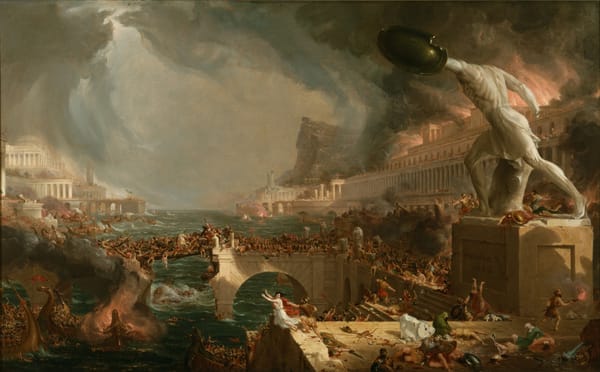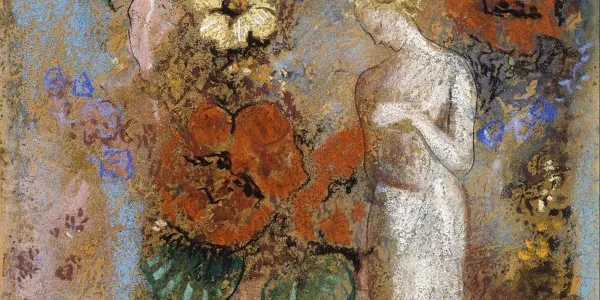We were a couple of songs into the Denver Taylor Swift concert, when I felt the the space that holds eternity move across the place that held me. The feeling surprised me, because I am not a Swiftie, I just live with Swifties. I am Swiftie-adjacent, I guess. And a Swiftie-adjacent person certainly had no reason experience transcendence somewhere between Lover and You Belong with Me.
And yet. There I was. Experiencing the elation of knowing there is something more. I turned to Riley, and spoke over our 11 year old dancing between us, “I feel God in in this The Era’s Tour.” A nod to an episode of The Office, where a drunk Pam Beesley stands up in a Chili’s and earnestly testifies, “I feel God in this Chili’s.” It’s a line I reference a lot, using it as shorthand to poke fun at the way I often find transcendence in places compromised by commodification. Usually Riley laughs at my little joke, but this time he just nodded with tears in his eyes. He felt God in this Chili’s too.
When it was all over, we joined the crowd moving from stadium to light-rail. After hours of ecstatic dancing, singing and chants, everyone looked a bit undone. I’d cried streaks through a glitter heart Riley painted on my face. Other people walked unsteadily, feet bare and blistered, high heels held in one hand and the crook of a friends’ arm in the other.
Silk flowers, fringe, strips of streamers, once carefully pinned to dresses, littered the grass dropping like petals. Everything felt subdued. Well, everything but the LED bracelets given to each attendee as they walked into the concert. Those still blinked bright colors around most people’s wrists.
The bracelets are made by Pixmob, a company that uses light to make spectators feel like they are participants in large, live events. During Swift’s concert, the bracelets lit up to match the color of each of the ten Eras as she moved through them onstage. Pink for Lover, purple for Speak Now. light blue for 1989. On their own, the bracelets feel a bit like a happy meal toy. But in a crowd of 73,000 people, the pin points of light came together to form something celestial.
Sometimes the LEDs blinked bright and white like stars flickering across a great distance. Another time, it looked like a sun was setting across the stadium from us in gradients of orange, pink and yellow. The bracelets made seers of the truly devoted, fans could read the colors the way ancient astronomers used to read stars. When the bracelets turned purple right before a surprise song, one of the Swifties sitting near us recognized the sign and screamed, “It’s going to be a song from Speak Now!” She was right.
Because the lights anticipated and reflected the color and lighting on the stage, it felt like they were lit by Swift’s presence. But they really blinked and shifted from one color to the next because of signals sent through infrared, or invisible light. After a lighting designer designed the light patterns they wanted to see in the and through the crowd, those designs were turned into commands. Those commands were put into computers that send them to transmitters set up around the stadium.
Those transmitters send out infrared data that is picked up by a receiver in each bracelet, and is then sent through a microprocessor that lights up the LEDs in the right colors, at the right rhythm. I thought the lights were beautiful, but I didn’t really see what they were illuminating until I’d taken it in from some distance.
On our way back to the train, I stood along a cement lined river and watched the people ahead of me walk under an overpass. The yellow lights along the path turned all their clothes one color, as their wrists blinked with light collected from the concert. And suddenly, I understood.
I’d felt transcendence because I’d been put through a journey designed to evoke spiritual emotion. I’d been on a pilgrimage. We all had. Those bracelets were ampulla, little vessels Medieval christian pilgrims filled with holy water and holy oil at shrines before turning towards home. Those liquids worked as intermediaries, materials that united a pilgrim to a shrine, even after they’d long left it behind.
The bracelets would stop blinking eventually, but for now, they were filled with a kind of sacred light. And even once they stopped emitting color, they could still function as an intermediaries material because they still had the capacity to receive and respond to Swift’s invisible light, if she ever saw fit to shine it on a faithful pilgrim once more. Pixmob’s tagline, Connect crowds, Reinvent rituals just felt incredibly apt.
Once I understood the concert goers as pilgrims, the stadium as a shrine temporarily consecrated by Swift’s physical presence, and Swift as a kind of venerated Saint, I thought I understood my experience. And it all seemed pretty sensible to me because The Eras tour economy and the pilgrimage economy have a lot of similarities.
First, Let’s talk about the pilgrims and the pilgrimage economy
Why did people go on medieval pilgrimages? With transcendence tied to the remains of saints and the structures that held them, a physical pilgrimage was one of a few ways the average person could hope to encounter God. The pilgrim set out to seek miracles, to demonstrate faith, to find faith, to earn forgiveness, to glimpse the cloaked dimension they’d been taught was more lasting than the one they moved through every single day.
Attire and accessories that marked the pilgrim as someone on a holy journey - long, coarse garments, a walking staff, a prayer book, sometimes they’d even carry portable altars.
I feel silly now that I didn’t recognize I was a fellow traveler on a pilgrimage on the way to the concert. The trains we took to the stadium were full of people in attire that made their devotion plain - fishnets with snakes hooked into the netting, peasant dresses in light yellows and deep greens, jean jackets embroidered with lyrics from their favorite songs, friendship bracelets piled from wrist to elbow.
Pilgrimage wasn’t just an aesthetic, it was a real financial sacrifice. Going on a medieval pilgrimage was an incredible expense, it cost more than a year’s wages to pay for the journey. And it could easily take a year to complete a pilgrimage, which meant the pilgrim lost out on another year’s wages.
While I am very much hoping no one has spent a year’s wage their Taylor Swift pilgrimage, Swifties are spending a lot of money to get to her shows. On average, concert attendees are spending $1325 on ticket, travel and clothing. The average ticket price is $215, so a lot of that money is being spent in the community around the concert instead of in the concert itself. Being a town along the Swift pilgrimage route is incredibly profitable. Economists are estimating the Eras Tour will generate over $4.5 billion for local economies where the shows are taking place. Her two nights in Denver alone generated $140 million of additional spending in Colorado.
In medieval Europe, towns grew along the pilgrimage routes, made hearty by the journey’s economic activity. Towns with shrines, promoted them with festivals to try to attract pilgrims and their purses. While traveling from shrine to shrine, pilgrims needed to pay for food, accommodation, banking services, security, medication, footwear, clothing, spices and pilgrim badges.
Pilgrim badges were little metal badges that depicted the saint at each shrine. They proved the pilgrim had reached their destination and they became holy objects when shrine custodians touched them to relics. The Church had a monopoly in making the badges, claiming they were the only ones that had the authority to create sanctified objects. It was a pretty nice revenue stream. Pilgrim badges were the first mass produced souvenirs in western history, with one site manufacturing and selling up to 80,000 badges in one year.
When I saw how long the merch lines were around the stadium, I felt a bit flummoxed. Why were people willing to wait for so long for an overpriced t-shirt with Swift’s face on it? But within the context of pilgrimage, the lines make little more sense to me. Fans wanted items screen printed with Swift’s face because it was one little way to prove they’d made the journey, sure. But it was also a way to transfer just a bit of the power of the evening to other parts of their lives. I can appreciate that. And I suppose it makes spending $75 on a sweatshirt a little bit easier for me to understand.
Money has always been tied to access. In the medieval period, the wealthy pilgrims had the means to purchase greater access to shrines and the relics within them. There were degrees of access at shrines too. One shrine was opened with a set of golden keys, that they themselves became holy relics - an actual sacralization of access. Which is little bit like holding on to a VIP badge long after the Eras tour has ended.
Taylor Swift made a few decisions that helped tickets overwhelmingly go to real fans - from selling to verified fans to not allowing primary sellers to have secondary markets. Only about 1100 tickets hit the secondary market for any given show. But not all fans had access to tickets.
Eras ticket holders were overwhelmingly people who could afford to take time off paid, or unpaid, work to scramble for tickets on Ticketmaster. There were a lot of white millennials at the show. As they purchased tickets, they could decide how much access they could afford. A floor seat with a separate entrance and a box of holy items sent to your house? Or the last seat in the last section?
Access does not prove devotion and devotion does not guarantee access. It was not uncommon for people who did not have the resources to enter a shrine, to gather around near a shrine in the hopes proximity would be enough. They were “ad pedes,” or “at the feet" of the shrine. The thousands of people Taylor-gating outside of every Swift concert are at “ad pedes” too. They listen for her voice outside the stadium and sing along once the sound finds them
Okay, now the saint and the shrine.
The journey between shrines helped create new trading routes and found new towns. But the shrines themselves were at the core of the pilgrim experience and pilgrim economy. They were revenue centers as well as places of revelation.
Medieval shrines were often structures dedicated to the protection and promotion of a saint. There are lots of different kinds of saints. Medieval pilgrims understood saints to be wonder workers and intercessors. They worked physical miracles with their physical remains. In order to become a saint, a figure had to be canonized by the holy see. Which I suppose was a little like getting signed by tour promoter with a monopoly.
Most shrines were built around a saint’s tomb. The saint existed in a kind of quantum superposition, alive in a tomb while also living in heaven. The shrine was the place where a saint’s relics - their bodies, or bits of their bodies - connected earth to heaven. And through that connection pilgrims could be healed and miracles could be worked.
Shrines were designed to provoke wonder and perpetuate mystery. One scholar calls this a “visual rhetoric of sanctity”…”that was not covert, but instead overtly used and understood by medieval viewers.”1It was not uncommon for the walls around a saints tomb to have elaborate murals of well-known religious scenes - a garden, a snake, a temptation, an ascent.
Some shrines even had automata - proto-robots that could nod, smile, frown, close their eyes. If a pilgrim was granted a smile from an automata of Christ, it was proof of their faith. Nuns and monks controlled them with hidden levers and pulleys. And I often wonder about the monks who decided to make Christ frown.
One Virgin Mary automata cried, the tears splashing out of her eyes because there was a fishbowl inside of her wooden head, fully of swimming fish. A trick that reminds me of the moment in the tour when Swift appears to dive into the stage and swim up it. As I watched, I knew the real Swift was under the stage changing and that the image I saw was just a projection. But still, I gasped.
It’s interesting to consider a single shrine within a shrine economy. Kind of like considering a single tour within a tour economy. Saints competed for market share with other saints. Shrine revenue was supposed to be divided in thirds and used to support the fabric of the Church, the local church, and the poor. Sometimes one category got more than the others. And entire towns and trading routes depended on the popularity of individuals shrines. So very early on, shrine custodians created a brand and marketing campaign for their shrines.
They segmented their audience when competition from another shrine became too fierce, so they could more effectively target “a particular subset of pilgrims.” Pilgrims seeking cures for reproductive issues might go to one shrine while pilgrims anxious to ease the burden of a prisoner might go to another. Specialization wasn’t always enough to keep pilgrims focused on a saint and shrine. Sometimes a saint went out of fashion and needed a little bit of a rebrand.
“Shrine custodians had to consider ways of renewing their brand. The traditional way of doing this was to organize a “translation” of the saints relics to a new and more grandiose tomb, an event marked by special ceremony, public celebrations…”2
There are all kinds of saints. If you were to ask my daughters, they’d tell you Swift is of the female mystic variety. Some of her songs feel like track-length visions to them. Others feel as unflagging as any intercessory prayer. There’s no sense that she’s interceding on their behalf with any version of a Christian God. But they do seem to have a sense that she can access dimensions they cannot.
It’d be difficult to dismiss the influence of a “visual rhetoric of sanctity” in the Era’s tour. The stage functioned as the tomb! Swift ascends from the stage at the beginning of the concert and descends back into the stage as the concert ends. And between that ascent and descent, she moves through a hyper-realized dimension. Depicting Swift being alive in a tomb and alive in some exalted realm at the same time kind of makes some artistic sense, as none of the people devoted to her will ever actually encounter her as a real person.
Pilgrims went to shrines hoping to receive a vision from the saint, a brief moment when the two realities joined by the saint’s body - the mundane present and eternal glory - come into focus for the the mere mortal. While the medieval pilgrim was often left wanting, the Swift pilgrim did not have to wait. The crowd gasped as their bracelets lit up to match the screens and air around Swift, making their bodies a part of the vision too. The stage stormed, burned, and bloomed around Swift. There was a garden, a snake, a temptation, an ascent.
Medieval shrines often went on tour! “Shrine custodians…could…take the relics on processions into the surrounding countryside in order to raise money from donations. These so-called ‘quests’ might be farmed out to a professional questor who would receive the revenues in exchange for a lump sum payment, a fixed salary or a profit split.” So yes, there were shrine promoters just like there are concert promoters today. And touring is still an incredibly effective way to make money from devotion. Swift’s tour will make about $1.5 billion by the time it ends next summer. And Swift will make about $620 million. (And that’s if there are no more concert dates announced.)
A lot of the persuasiveness of the shrine lay in its material sense of immediacy and intimacy. It had to or else the pilgrim wouldn’t sacrifice years of their life and wages to share space with the shrine. So as the shrine traveled, it was important to find ways to meaningfully connect it to its temporary communities. It’s fascinating to consider Swift’s two surprise songs, never repeated at any stop, within this context.
Those songs are a brilliant way to create a distinct physical connection between her traveling shrine and each community it moves through. I guess songs don’t feel very physical until you think about the fact that sound is a wave. At each concert, Swift sings two songs that will only reverberate against that crowd’s ears.
While the tomb might grow grander, and the shrine might tour, the depictions of the saint had to essentially stay the same. The saint could not drastically change, because the saint could not be affected by time. It had to exist outside of time, a figure that could bring their past encounter with the divine to a pilgrim’s present. It’s this aspect that I think makes Swift’s touring shrine so effective. She greets the pilgrim in a past era, and then moves back and forth across the past before returning to the present.
ALSO. I have a prediction! About the Eras Tour!
It’s the saint’s duty to be in both the past and present that has me pretty convinced that more dates will be added to create a new end of the tour. The thing with promoting sainthood is that storytelling and physical presence matter equally. It makes little sense for Swift’s mobile shrine to end its tour in London, a place that does not have enough meaning to ground her in her past at the same time as it makes her accessible in the present.
For her to maintain the sense that she can move into her past to help a pilgrim survive their present, she has to go all the way back home. From London, to a few shows in Canada, to one more short US leg with a final show in Nashville, where she’ll debut the color, light and sets for her first album.
We’d gotten to the train by the time I’d worked all this out in my head. And I wanted to feel satisfied with my understanding. Religion has lost its power to move the western collective. And music has become a kind of liturgy for a lot of people. Instead of a cult of saints, we’ve got a cult of stars.
The Eras Tour environment resembled other environments designed to evoke feelings of transcendence. Veneration is catchy and the Cruel Summer bridge is too. The LED lights weren’t actual transmissions from Swift. And so those bracelets weren’t really ampulla. It was a nice time! But God was not in that Chili’s.
And yet, I just couldn’t shake the feeling that I’d encountered something divine in that arena.
It wasn’t until the next day, when the light had gone from my LED bracelet that I considered another, less exalted wearable. I realized, I’d felt God in that Chili’s when Swift was not on stage.
My eleven year old started making friendship bracelets a few days before we went to the show. We’d read online that everyone made lots of bracelets and traded them with each other. She worked so hard on hers, staring into the middle distance as she thought of words to include in each bracelet. Selecting one plastic bead at a time, creating a perfect palette for each era. When one bracelet broke as she tried to tie it, she allowed herself one sigh and then picked up the beads and started again.
But when we approached the stadium, she pulled the bracelets from her wrist and shoved them in my bag. The thought of talking to strangers, even to trade bracelets, was overwhelming. She’d try to trade bracelets next time. Maybe.
Swift was transitioning between eras when a man in the row in front of us turned around. He held out his wrist to Viola and asked if she wanted a bracelet. She panicked, afraid to talk. So I shrugged my shoulders and said, “She doesn’t have any bracelets to trade.”
He smiled. He’d seen she wasn’t wearing any bracelets and so wanted to give her two. Would she like that? She would. He then explained the meaning of every bracelet on his arm and let her choose. That would have been enough. She was so happy.
But then, the man he’d been dancing with took a bracelet off his wrist and gave it to Viola too. And the women sitting next to him did the same. And everyone sitting to my left began to pass down bracelets. Until she had so many bracelets, they didn’t all fit on one wrist. She cried with the joy of it. Riley cried and hugged the man. And I cried and hugged Viola.
I’d spent all that time thinking about the effect of the shrine on the pilgrims, but I hadn’t thought about how the pilgrims might actually sanctify the shrine.
Okay, so maybe medieval shrines were designed to evoke emotion and offerings. And yeah, there was a large insitution intent on maintaining authority deciding who got to be a saint and who didn’t. And absolutely, lots of people walked into shrines seeking visions and connections left squinting into the light because they’d been in the dark too long.
But what about the people who did have visions in those spaces? What about the types of pilgrims who can consecrate anything, even plastic beads?
The man who offered Viola his bracelets was queer. What he couldn’t have known is that the little girl he felt moved to help is queer too. And he showed Viola that found family can be found anywhere. That offerings don’t have to cost much. And that while pilgrimages might have merit, any space can become holy ground.
That was the moment I felt the space that holds eternity move across the place that held me. And when I think long enough about it, I think I might have seen it too. Just the quickest glimpse. I thought it would be golden, but it was green.
(The man’s name was Brady. Brady, if you’re reading this, I love you forever.)

1 Hahn, Cynthia. “Seeing and Believing: The Construction of Sanctity in Early-Medieval Saints’ Shrines.” Speculum, vol. 72, no. 4, 1997, pp. 1079–106. JSTOR, https://doi.org/10.2307/2865959. Accessed 20 July 2023.
2 BELL, ADRIAN R., and RICHARD S. DALE. “The Medieval Pilgrimage Business.” Enterprise & Society, vol. 12, no. 3, 2011, pp. 601–27. JSTOR, http://www.jstor.org/stable/23701445. Accessed 19 July 2023.








